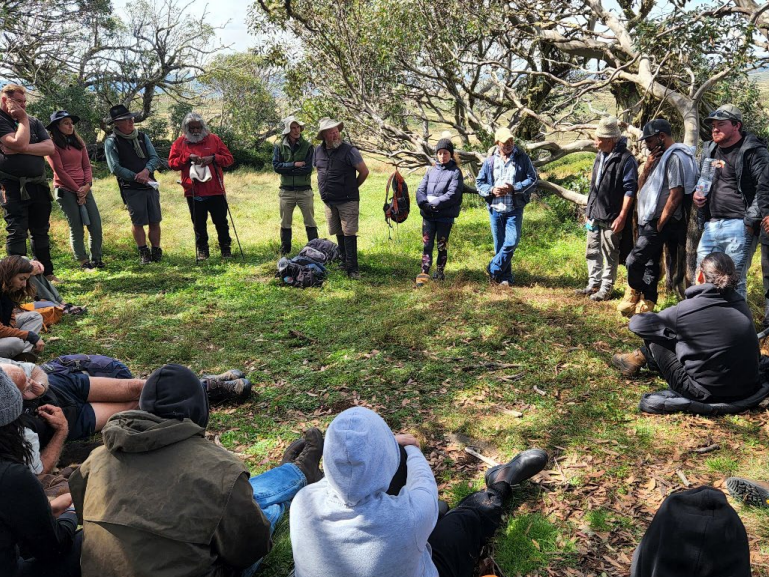Community stories: 28 February 2024
Jaithmathang TABOO is an Indigenous organisation working on Country in North East Victoria to support regeneration in the landscape’s recovery following the 2019/20 bushfires, and to support cultural healing.
They were awarded a $120,000 grant in April 2022 (to be paid over three years) from FRRR through the Bushfire Recovery Fund, which is supported by the Helen Macpherson Smith Trust and the Sidney Myer Fund. The funding was for a program of annual cool burns and to work with key environment and government stakeholders to share learnings.
The project, titled ‘Beginning the journey to cultural healing on Jaithmathang Country’, specifically aimed to build the capacity of the organisation by contributing to the cost of employing a Jaithmathang descendant for three years to project manage the cool burning program in the Falls Creek region. It also aimed to help in establishing ongoing partnerships and engagement with key stakeholder organisations that can support Jaithmathang to operate sustainably into the future as custodians on Country.

The organisation recently submitted an interim report about what they did in the first year of funding. FRRR’s Program Manager, Danielle Griffin, says the group should be really proud of what they’ve achieved in the first year.
“In year one, Jaithmathang has successfully engaged with the targeted government, First Nations and subject matter expert stakeholders to support their foundational return to Jaithmathang Country. As the Jaithmathang Elders belong to the stolen generation and were removed from Country, it is a privilege to be involved in this significant work to build their capacity for returning to Country and participate in local recovery through disaster management and the intrinsic healing practices that will support Indigenous land and people. The tripartite partnership is a great outcome for year one of this grant,” she said.
The following is an extract from the report, which provides more detail on the background and the partnerships created to date.
The countryside of Bimble is our age-old family tree and it reflects in its rich and diverse lands, the history and heritage of the Jaithmathang Original Peoples. It is our most ancient landscape and it is beautiful and life giving. Mung, Tyer and Buller and all creatures and living things created by Bunjilla are respected and form part of the interconnected ecosystem where each is essential to one another. Our women, men and children are connected through birth right to our Bunjilla Dreaming Bimble, where we reconnect with our spiritual origins and renew our sense of belonging and meaning.
Cultural burning, or the use of fire as a tool for managing landscapes, was an intrinsic part of the connection to country for many Indigenous cultures. Cultural burning is a deeply cultural and spiritual practice that played an important role in the relationship between Indigenous people and our land. It was a tool for managing the land, communicating with the spirits, and maintaining a strong connection to country.
Despite the worsening severity of bushfire activity in Australia, the recognition and adoption of meaningful cultural cool burning as part of a defensive strategy is still in its infancy in current land management practices. We have developed strong partnerships with private landholders and government to achieve the access, consent and participation from all stakeholders required to build an effective approach to fire management, underpinned by traditional knowledge and practices. However, resistance to the introduction of more traditional fire management practice is problematic and will require ongoing work, coordination and support.
Jaithmathang TABOO, Nallawilli Bunjil and CSIRO have creating a tripartite working group to reintroduce traditional cultural burning practices and Indigenous fire knowledge into modern fire management. Nallawilli Bunjil is a commercial drone surveillance and data modelling organisation led by Jaithmathang Elder Roderick McCleod, which provides expertise in virtual modelling to capture real time data about a landscape, including temperature, weather conditions, and for the purposes of fire management, fuel hazard. All parties aim to enhance the health of the land and its Indigenous people.
The outlined project supports developing Monitoring, Evaluation and Research (MER), contributing directly to the Victorian Traditional Owner Cultural Fire Strategy. Jaithmathang TABOO has agreed to work closely with neighbouring nations, including Gunaikurnai Land and Water Aboriginal Corporation. The project will coordinate with the Department of Environment, Energy Climate Action, Federation of Victorian Traditional Owner Corporation, Country Fire Authority and Parks Victoria as priority stakeholders of the project.
CSIRO has developed a bushfire model called Spark, an end-to-end interactive 3D processing tool to predict fire behaviour, based on existing fire spread models. The system has been developed with the capability to be customised for use in risk management, planning, fire spread, research, prescribe burns and fire response.
Spark ingests fuel availability, load, topography and gridded weather based on an ignition point or ignition pattern. It then simulates the temporal and spatial extent of the fire, providing mitigation and contaminate strategies for ongoing bushfires. The project will pilot MER to help start building an accurate cultural burn model for eucalypt forests, undertaking fundamental field observations pre, during and post, documenting on country and operational cool burning methodology.
In reducing the occurrence, intensity and severity of wildfires, cultural burning has an array of interconnected objectives. These include cultural asset protection, habitat protection, biodiversity recovery, fuel reduction, waterway restoration and bush regeneration.
The important role that cultural burning can play in healing and improving the long-term health of country is increasingly being understood, and resources that support cultural burning such as the Traditional Owner Cultural Fire Strategy, support the expansion of cultural burning in Victoria.
The third phase will be to plan and conduct Cultural mosaic burns within the pilot area, sampling major vegetation, typography, weather /moisture and escape risk assessment. A project report will be compiled by CSIRO comparing cultural cool burn management to standard practices today, outlining the potential benefits of Indigenous Fire Practitioners.

